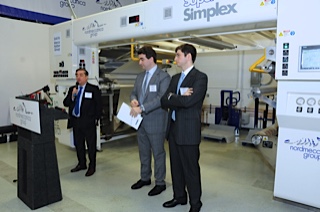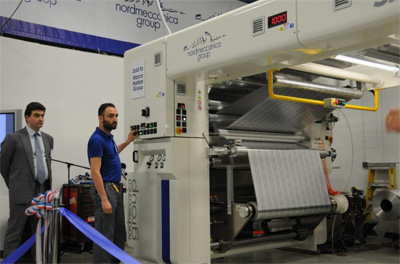Nordmeccanica Demonstrates Solvent-Free Adhesive Laminating
- Published: June 08, 2015, By Tom Bezigian
Nordmeccanica moved only a few miles from its former location, but now has a permanent North American  headquarters office, showroom, and warehouse in Hauppauge, Long Island, NY. The ribbon cutting ceremony was fun, and done in Italian style and grandeur.
headquarters office, showroom, and warehouse in Hauppauge, Long Island, NY. The ribbon cutting ceremony was fun, and done in Italian style and grandeur.
There were talks by company officials on the history of the company, as well as several technical presentations by several different people. Vincenzo Cerciello, president of Nordmeccanica NA and technical director Nordmeccanica Group, gave a presentation on barrier webs. Dr. Duncan Darby, associate professor in the Food Nutrition and Packaging Sciences Dept. at Clemson University in Clemson, SC, gave a practical and very excellent presentation on the properties and converting of aluminum foils. Last, but not least, the master of ceremonies and commercial director for Nordmeccanicca NA, Giancarlo Caimmi, gave a presentation on the lamination of barrier webs.
 While all of this was fun, interesting and informative, the "real meat and potatoes," so to speak, was in the machine demonstration itself. Nordmeccanica demonstrated the lamination of a 5μ aluminum foil supplied by Hydro Aluminium (Düsseldorf, Germany) to a printed oriented polyester (OPET) film supplied by Ultra Flex Packaging (Brooklyn, NY) with an undisclosed solvent-free adhesive on a completely standard 59-in. (1.5 m) Super Simplex line.
While all of this was fun, interesting and informative, the "real meat and potatoes," so to speak, was in the machine demonstration itself. Nordmeccanica demonstrated the lamination of a 5μ aluminum foil supplied by Hydro Aluminium (Düsseldorf, Germany) to a printed oriented polyester (OPET) film supplied by Ultra Flex Packaging (Brooklyn, NY) with an undisclosed solvent-free adhesive on a completely standard 59-in. (1.5 m) Super Simplex line.
Web handling is the key to laminating lightweight foils, and I can say that the Super Simplex unwind was ROCK SOLID. To me this was the key to the whole demonstration being successful. Nordmeccanica has found the winning formula of unwind stand rigidity; unwind motor size and control; idler roll design, balance and fabrication; 4-roll laminator design and speed control; line tension control; and speed ramp-up protocol to produce a new structure heretofore unmade in the US. The fascinating thing is that all this comes in a standard line, at standard pricing, versus custom-machinery pricing.
 Both the first and second pass lamination steps of foil to OPET film, then lamination to OPET film were done first at 600 ft/min (182 m/min), which is the speed at which no voids are observed from the curing process in the solventless adhesive, and then at 1,000 ft/min (304 m/min) to demonstrate the capability of the machine.
Both the first and second pass lamination steps of foil to OPET film, then lamination to OPET film were done first at 600 ft/min (182 m/min), which is the speed at which no voids are observed from the curing process in the solventless adhesive, and then at 1,000 ft/min (304 m/min) to demonstrate the capability of the machine.
The ramifications of using thinner foils are obvious, namely lower raw material costs. Reducing the foil component from 7μ to 5μ reduces the foil component weight by 28%, which should result in a 10% cost reduction. As Dr. Darby mentioned in his presentation, American converters are more or less stuck in the past with notions about aluminum foil, which translates to reduced efficiency and productivity and increased cost, thus putting US manufacturers at a competitive disadvantage.
 All in all, I was very impressed with the machine, the foil, and the adhesive, which took three full days to cure. The operative word to remember about the machine is ROCK-SOLID. Well, it might be two words, but you get the idea. Look for a full-length article on this topic soon at www.PFFC-online.
All in all, I was very impressed with the machine, the foil, and the adhesive, which took three full days to cure. The operative word to remember about the machine is ROCK-SOLID. Well, it might be two words, but you get the idea. Look for a full-length article on this topic soon at www.PFFC-online.


